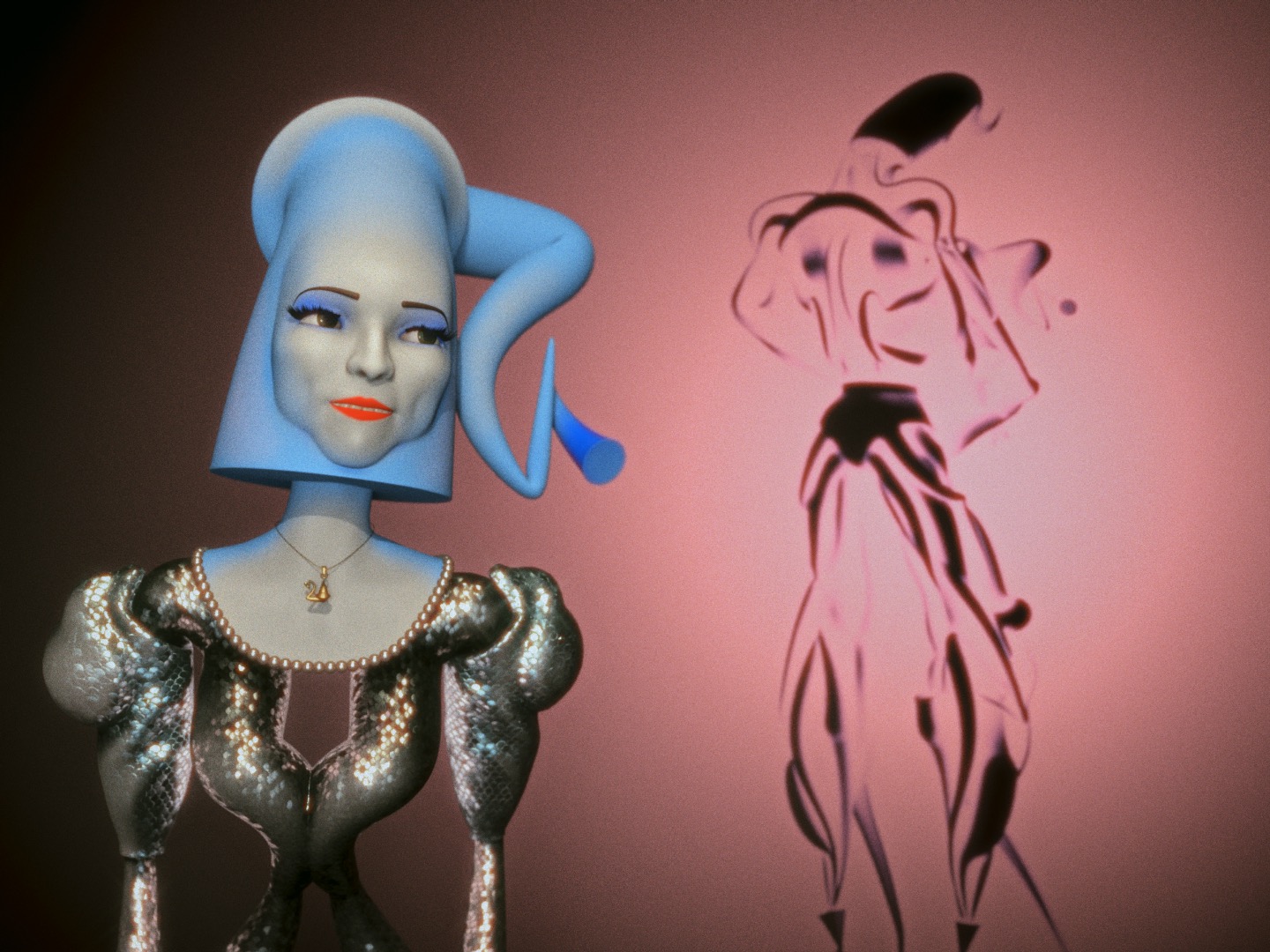SAN FRANCISCO — David Bayus has his media fun while tweaking it too — in Performance Anxiety, an exhibition at Telematic, he recasts the classic Hollywood musical genre and its associated gender stereotypes. For the show’s eponymous 10-minute video centerpiece (2024), Bayus unspools a lively, dark-edged, and playful mashup that refracts Art Deco and noir melodrama through the late-modern styles of video games, manga, and fantasy horror via Computer-Generated Imagery. In the gallery’s small, moodily lit space, a pair of other objects — a single painting and a small statuette — hover near the screen, casting their own dim glows and fitfully teasing additional facets of the video’s unvoiced narrative.
The video’s animated figures feature Alice in Wonderland- and Ubu roi-like heads, cartoony faces flashing broad expressions. These sit atop exoskeletal bodies in the darker fantasy modes of H.R. Giger, Robocop, or Terminator — dynamic exquisite corpses generated via artificial intelligence-enabled motion capture. Reversing conventional damsel-in-distress rescues, it is the heroine in the video who saves the day for both herself and a male protagonist, whose insecurities seem to get the better of him while performing domestic chores. The characters’ uncanny affects are not quite emotions, but, rather, exaggerated caricatures à la both digitally drawn animations and old-time-y actors. The twilit interiors of both video world and gallery space, however — accompanied by ominous ambient undercurrents hovering beneath the soundtrack’s two vintage song knockoffs — suggest that something emotional might really be at stake.

On a pedestal flanking the video, “Participation Trophy #1” (2023) — a 3D-printed sculpture of a cartoony humanoid figure jauntily holding its own decapitated head — recalls a higher-end Disney gift shop souvenir, but the muted lighting yet again shifts the mood, showcasing the figure’s striking, unnatural contortions frozen in a domestic dance scene taken from the video. On the wall flanking the video’s other edge, a biomorphic figure and a machine threaten to meld into one another in the Dalí-like painting “Division of Labor” (2024). The resulting half-living apparatus’s dormant tubing smolders like the infrastructure of an unlit neon sign, furthering the noirish-ness of the exhibition. In some ways, the biomorphic fragment in “Division of Labor” and the androgynous humanoid of “Participation Trophy” move further afield from more binarily gendered figures, suggesting some greater “spinoff” that might happen beyond the frames of the video’s confines.
Throughout, Bayus works this ensemble of distinct yet related media works with great facility, verve, and style, while proposing an intervention on gender stereotypes. Though intended as sincere inversion of social expectations, the video’s narrative still hews to a heteronormative schema in performing a simple gender role swap that nevertheless reinforces set categories rather than pursuing full-on paths of greater gender unfolding.
Perhaps such defaults are a consequence of the use of AI and its tracking and regurgitation of established associations between formal elements and human concepts, such as the coding of certain physical labors (e.g. cleaning vs. fighting) as “feminine” or “masculine.” Though the combined outcomes of the exhibition’s pieces sidestep the most obvious ideological pitfalls of gender relations, they do not entirely escape the orbit of default logics for social roles. Ultimately, Bayus demonstrates how contemporary media can artfully represent and reflect the vexed social legacies of popular cultural production in funny and poignant fashion — but not how to shed them entirely.



David Bayus, Performance Anxiety: Painting, Sculpture, and Film, continues at Telematic (323 10th Street, San Francisco, California) through November 9.

